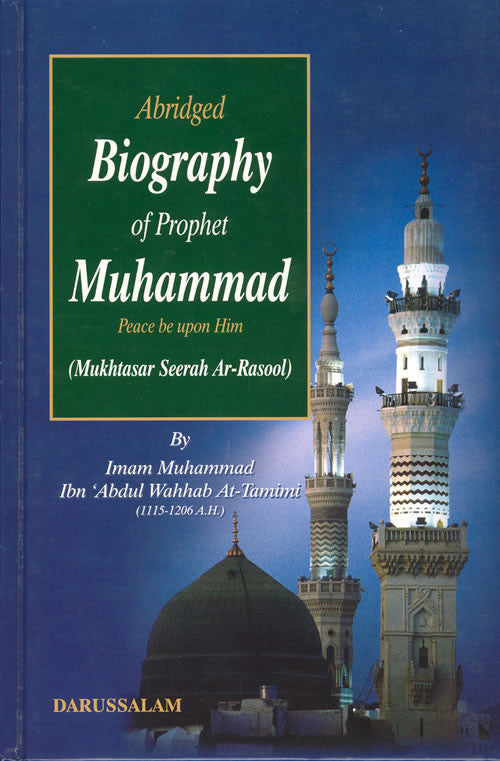
| Author | Imam Muhammad Ibn Abdul Wahhab At-Tamimi |
| Binding | Hardback |
| Pages | 398 |
| Size in Inches | 6x9 |
| Size in Centimeters | 15x22 |
| Actual Weight | 1.31 |
Brief Synopsis:
This book is an English translation of Mukhtasar Seerah Ar-Rasool by Imam Muhammad Ibn 'Abdul Wahhab At-Tamimi. It presents authentic details of the life of Prophet Muhammad (SAW) concisely. It is replete with Quranic references which are translated into English to maximize understanding. The book is unique as:
- It is the result of relentless efforts of Imam Muhammad Ibn 'Abdul Wahhab, whose works have not been published earlier than this.
- It covers all details of the life of the Prophet (SAW) despite being precise.
- The division of the chapters is neat which provides ready access to different eras before and after Prophet-hood.
The knowledge of the biography of the last Messenger can help all Muslims lead their lives according to the true spirit of Islam and attain Allah’s forgiveness and happiness.
Description:
Translation of Mukhtasar Seerah Ar-Rasool
Many books have been published on the Biography of the Prophet (S) by different authors and compilers, but this book is different from them as it has been written by the great Imam Muhammad Ibn 'Abdul Wahhab At-Tamimi and never published before.
A committee was appointed to collect the writings of Imam Muhammad Ibn 'Abdul Wahhab throughout the Muslim world and compile this book from printed, handwritten and microfilm sources.
Introduction
After Imam Muhammad bin Sa'ud Islamic University had decided to hold a conference in the name of Shaikh Muhammad bin 'Abdul Wahhab, it formed a committee to prepare for this conference and to provide a detailed concept of it and then to implement it.
The committee began its work by restating its general objective for the conference, which was to inform people about the Shaikh and reveal the truth of his Da'wah throughout the Muslim world and to dispel the doubts and uncertainties about it which have become common in some Islamic countries and during certain periods in history.
While striving to attain this objective in a scientific and correct manner, the committee came to the conclusion that it was necessary to collect all of the Shaikh's written works and to substantiate their attribution to him and to confirm it, then to publish them in a special printing in the name of the University, in order to send copies of it after that to the organizations and researchers who would be invited to take part in the conference. Regarding this, the committee kept in mind the fact that many researchers in Muslim countries do not have available the books of the Shaikh and his written scholarly works, which would, without any doubt, have a clear effect on the shortcomings, incompleteness or mistakes of some of the things which they might write about the Shaikh's Da'wah, for that reason, it was essential the genuine works of the Shaikh be available to them in an authentic form, so that they might become acquainted with the truth of his Da 'wah and the unbiased scholarly works which have been written about it.
Hence, the committee proceeded to collect all of the works of the Shaikh which they could, both printed and handwritten and to search for them in every place they could think of, with individuals belonging to the Shaikh's family, in public and private libraries and in all parts of the Kingdom and outside it. In this regard, we would like to indicate the large number of handwritten works of the Shaikh which we found in As-Sa'udiyyah Library at Dukhnah, in Riyadh; the committee copied these manuscripts and they also obtained copies of the printed works of the Shaikh by purchasing them, being given them as gifts, through private connections and by borrowing some printed works which were few in number or were rare from individuals and organizations.
The Committee also published and broadcast an announcement, in which they called upon those who possessed any written or printed works of the Shaikh to present them to the Committee; and they sent letters carrying the same meaning to a number of well known personalities who had ties to him and his family, both in the Kingdom and abroad.
They also made personal contact with some individuals who had some special interest in the Shaikh, his Da'wah and his written works, or who had written something of value about them. Also, during the summer vacation of the year 1396 A. H. (1976 C. E.), some members of the Committee undertook a search of some of the important libraries in Egypt and other countries in order to become acquainted with any of the works of the Shaikh which might be there and then to work on bringing whatever was possible from these works to help with the requirements of the Committee.
As a result of all this, many copies from among the works of the Shaikh were collected, both printed and handwritten and on microfilm. Then a board was appointed from among the members of the Committee to classify these works and their responsibilities included the following:
1. Examining each work, whether printed or handwritten and verifying that it was really one of the works of the Shaikh. 2. Gathering all of the printed and handwritten copies and describing each copy. 3. Recording the category in which each work belonged (Aqeedah [Beliefs], Fiqh [Islamic Jurisprudence], Seerah [Biography of the Prophet (S) and treatises)
Also, a number of subcommittees were formed for the purpose of authentication and their responsibilities included the following:
1. Comparing the printed and handwritten copies of each book with each other in order to obtain a complete copy, which could be prepared for printing. 2. Numbering the Quranic Verses, mentioning the Surahs from which they came and adding the diacritical marks to them. 3. Adding punctuation and paragraphs and making the chapter headings stand out, in accordance with the modern system of writing and printing. 4. Ascertaining the authenticity of works presented to the board of classification whose attribution to the Shaikh was in doubt. The Conference Committee took great care that every one of the authentication subcommittees was composed of specialized scholars with a strong connection to the type and nature of the work which they were reviewing. They also took care to the best of their ability, to ensure that each subcommittee brought together a number of scholars whose collective expertise in the field of authentication was complete. And in this regard, the Committee sought help from some expert scholars from outside the Committee.
So these works of the Shaikh, the conference Committee presents, complete and authenticated, as the first result its formation and its work. And what the Committee intended by its efforts was to reveal the truth of the Shaikh's Da'wah and to make it easy for people to study it and refer to it, based upon all of his written works, without addition, omission or commentary, to allow those who study, write and search for the truth regarding it to reach it by the firmest path, whilst avoiding every untruth, distortion or false claim, the bearer of which seeks to disguise the truth.
And the Committee expresses the hope that the success of its work is equal to the efforts which its members have exerted.
Table of Contents:
- Introduction
- The Fight against the apostates
- Another story which took place during the era of righteous caliphs
- What took place during the era of righteous caliphs
- What took place during the era of companions also
- What took place during the era of Tabi'un
- The story of Banu 'Ubaid Al-Qaddah
- The story of tartars
- The genealogy of the Prophet
- The story of the elephant
- The death of 'Abdullah,the father of Allah's messenger
- 'Abdul Mutalib ,the grandfather of Allah's Messenger
- 'Abdullah ,the father of Allah's Messenger
- 'Abu-Talib ,the uncle of Allah's Messenger
- His journey to Ash-sham and his marriage to Khadeeja R.A.
- His seclusion in the cave of Hira'
- The rebuilding of -the Ka'bah
- Some of the beliefs of the people of Ja'ahiliyya
- 'Amr Bin Luhayy was the first to change the religion of Abraham
- The Idol of Manat
- The idol of Al-Lat
- The idol of Al-'Uzza
- The idol of Hubbal
- Dhul-Khalsah
- The Idol 'Amm-Anas
- The Start of the revelation
- Types of the revelation
- The first to believe
- The story of Zaid-Bin Harithah
- Sumayyah,the first Martyr
- The beginning of the call:(To Allah)
- The first Blood Spilt
- The Mockery of the Polytheists
- The first migration to Abyssinia
- The second Migration to Abyssinia
- The Messenger of Allah's letter to negus,Requesting him to give Umme Habeebah in the Marriage to him:
- Quraish send to the negus a request for the return of the Muslims
- The death of the negus
- Hamza 'Bin 'Abdil Muttalib R.A. embraces Islam
- Umar R.A. embraces Islam
- Abu-Talib's protection for the messenger of Allah
- The boycott of Abu-Hashim in canyon
- The annulment of the document
- The death of Khadeeja and Abu -Talib
- Their question regarding the soul and companions of the cave
- What Al-Waleed Bin Al-Mughe'erah said regarding the Qura'an being Magic
- The splitting of the moon
- Their request for signs
- The departure of Prophet(P.B.U.H.) for Al-Tai'f
- Al-Isra' and Al-Mi'raj
- Chapter:Regarding the Hijrah
- The first Pledge of Al-Aqabah
- Sa'd bin Mu'adh and Usaid Bin Hudair Embrace Islam
- The second pledge of Alligiance of Al-Aqabah
- The migration(hijrah) to Al-Madina
- Quraish plot to murder the messenger of Allah(P.B.U.H.) in Dar-An-Nadwah
- The story of Suraqa Bin Malik
- The story of Umm Ma'bad
- The Messenger of Allah entering in Al-Madina
- The Building of mosque
- The consummation of his marriage to 'A'ishah R.A.
- The brotherhood between the Ansar and the Muhajirin
- The events of the first year
- 'Abdullah Bin Salam embraces Islam
- The events of the second year
- The changing of the Qiblah:
- Chapter
- Some of the qualities of Messenger of Allah
- The first Platoon sent out by the Messenger of Allah
- The expedition of 'Ubaidah Bin Al-Harith
- The expeditin of Sa'd Bin Abi-Waqas
- The Battle of Al-Abwa'
- Allah Benefited Tai' through 'Adiyy Bin Hatim
- Fighting the Apostates
- Abu Bakr's letters to his commanders
- The story of Khalid's march to Buzakhah and other places
- The story of return of Banu 'Amir and others to Islam
- Khalid's Expedition to Al-Yamamah
- The story of the apostasy of people of Al-Yamamah, having been led astray by the Musailmah the Liar
- Khalid sends out scouting parties form Al-Butah
- The story of apostasy of Banu-Sulaim
- The killing and burning of Al-Faja'ah
- The story of apostasy of the people of Bahrain
- The story of apostasy of people of Dabba and Banu Azad Of Oman
- The twelfth year
- Khalid's Expedition to Iraq
- The events of the thirteenth year
- The death of Abu-Bakr As-Siddique R.A.
- The events of Fourteenth year
- The events of Fifteenth year
- The conquest of Al-Qaddissiya
- The events of Sixteenth Year
- The events of Seventeenth year
- The events of Eighteenth year
- The events of nineteenth year
- The events of twentieth year
- The events of twenty First Year
- The events of twenty second year
- The events of twenty third year
- The events of twenty fourth year
- The events of twenty fifth year
- The events of twenty sixth year
- The events of twenty seventh year
- The events of twenty eighth year
- The events of twenty ninth year
- The events of thirtieth year
- The events of thirty first year
- The events of thirty second year
- The events of thirty third year
- The events of thirty fourth year
- The events of thirty fifth year
- The Battle of the Camel
- The events of thirty seventh year
- The events of thirty eighth year
- The events of Fortieth year
- Then the forty-second year began
- Then the forty-third year began
- The the Forty-Fourth year Began
- Then the Forty-Fifth Year began
- Then The Forty-Sixth Year Began
- Then The Forty-Seventh year Began
- The events of the Forty-Ninth year
- Then the fifty-First Year Began
- Then the fifty second year began

